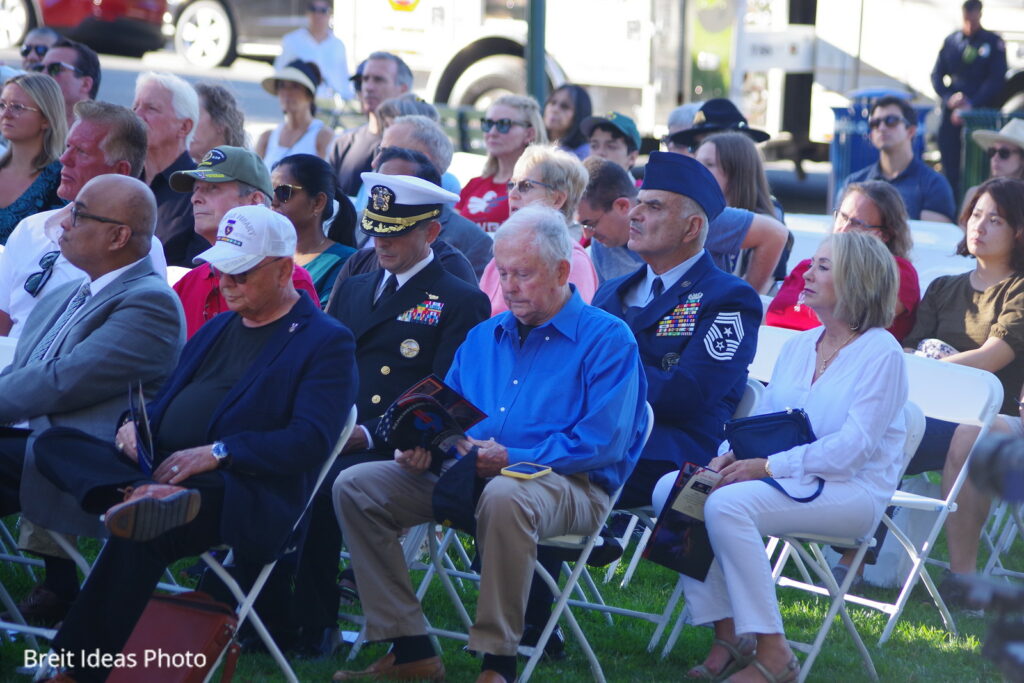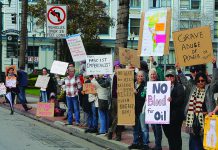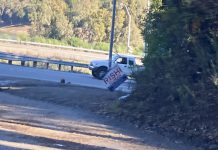
In On That Day: the definitive timeline of 9/11, author William M. Arkin notes that at 9:36am on Sept. 11, 2001, Lt. Col. Kevin Nasypany directed fighter jets based out of Langley go straight to Washington to be available to intercept incoming threats.
By this time, both of the World Trade Center buildings had been struck by aircraft and two additional planes had been hijacked, including United Airlines Flight 93, with Los Gatos High School graduates Todd Beamer and Mark Bingham on board.
“Shortly afterward, Lt. Col. Nasypany discovers, to his surprise, that the Langley-based fighters have not headed north as the scramble order had instructed but instead went east over the ocean,” Arkin wrote. “His response is emotional: ‘I don’t care how many windows you break,’ he says he ordered the unit. ‘Damn it…OK. Push them back.’”
But they didn’t make it back—at least not in time to stop American Airlines Flight 77, which accelerated to 530 mph, clipped five lamp posts and hit a portable generator before slamming into the Pentagon, killing 125 people—including 70 civilians.
The Langley F-16s were still about 100-150 miles away from the Pentagon at the time, and the passengers of Flight 93 were already considering storming the cockpit.
At 9:48am, flight attendant CeeCee Lyles left a message for her husband, telling him about the hijacking.
“We’ve turned around, and I’ve heard that there’s planes that’s been, been flown into the World Trade Center,” she said. “I hope to be able to see your face again.”
At the very same moment, NORAD commander Ralph Edward “Ed” Eberhart decides against ordering hijacked planes to be shot down, for the third time.
Dozens of nuclear weapons had been loaded onto bombers in Louisiana, North Dakota and Missouri, with ballistic missile silos and Trident submarine crews on alert, as defense officials imagined a new Cold War may have just started.
At 9:53am, the National Security Agency intercepts a phone call from an Osama bin Laden operative in Afghanistan to a former Soviet Republic of Georgia number, noting he’s heard “good news” and that there might soon be more to share.
A minute later, President George W. Bush makes a two-minute phone call to an unidentified person.
Meanwhile, Flight 93 passenger Honor Elizabeth Wainio was speaking with her stepmother on the ground, telling her other passengers had begun mounting their counter-terrorism operation.
“I have to go,” she said. “I love you. Goodbye.”
At the time this call was made, Defense Secretary Donald Rumsfeld was still out of communication following the Pentagon attack and some authorities worried the Sears Tower in Chicago could still be hit by another aircraft.
The South Tower collapsed at 9:59am, a minute after Lebanese hijacker pilot Ziad Jarrah began to roll Flight 93 from right to left to try to knock the passengers off balance.
“The cockpit voice recorder captures the sounds of loud thumps, crashes, shouts, and breaking glasses and plates,” the book notes, adding someone was heard yelling, “Stop him!”
At 9:59am Eberhart, the NORAD commander, declared an Air Defense Emergency, the highest air defense alert that provides the authority for scrambled air defense assets to shoot down hijacked planes after NORAD receives “White House interest,” Arkin wrote.
Questions would linger about whether an order to shoot down planes was actually given by Bush, or if his authority was usurped by Vice President Dick Cheney, who was not part of the military chain-of-command.
This point was rendered less significant due to the actions of the passengers of Flight 93, as the executive branch initially thought its order took down the hijacked aircraft.
George Sikich, a Kiwanis Club of Los Gatos member, recalled how his wife Nancy Pearson called him that day while he was on the Bay Bridge to tell him New York had been attacked.
He’d been on his way to a boat show.
“This is something that always should be remembered,” he said. “What people did was remarkable.”

Sikich was one of many who attended the 9/11 memorial held at the Flame of Liberty monument in Los Gatos Sunday evening, which highlighted, among other things, the bravery of Beamer and Bingham.
“I had one friend die who was in the Trade Towers,” Sikich said. “He was a bond trader.”
The event was a good way to look back on that tragic day, he added.
“It was very moving,” Sikich said. “It was short and to the point.”
Parks Commissioner Matt Ober said the permanence of the Flame of Liberty memorial means Los Gatos marks the deaths of the victims all year, not just on the 11th day of September.
“I think it is an honor and a tribute to those who’ve fallen on a terrible day,” he said of the ceremony.
Rob Stephenson, board director of the Veterans Memorial and Support Foundation, said he was glad the event had such a meaningful effect.
“This was our generation’s Pearl Harbor,” he said. “We have an entire generation now that are adults and weren’t alive when it happened.”
Colin Kennedy, 12, certainly wasn’t even a twinkle in his mother’s eye back in 2001.
He served as the commander of the color guard for this year’s memorial, joining other Boy Scouts of America Troop 539 volunteers.
Kennedy said it was quite similar to the one he’d helped out with in 2021.
“It was great to be here,” he said. “It’s less about the event and more about remembering.”
Lt. Col. Walker Pearce-Pearcy, who flies C-5 cargo airplanes out of Travis Air Force Base, was responsible for organizing the ceremony.
“I think it really highlighted the important aspects of remembering that day,” he said, adding it was great to see the youth participate. “Just having them involved is what we’re here to do.”
Retired Maj. Gen. Kent Hillhouse said the program was designed to honor heroes and support victims, and to reflect on the contributions of Bingham and Beamer.
“We had some great speakers,” he said. “I told the mayor if I knew her speech was going to be so impactful, I would have brought a box of tissues.”
Mayor Maria Ristow noted her own daughter—who was one year old on Sept. 11, 2001—is now 23.
“I also wanted to honor the families,” she said. “Those families still have this gaping hole.”
Ristow said it’s important to reinforce American values like integrity, inclusion and putting others above yourself.
“We don’t need another tragedy to remember our values,” she said. “We need to not let petty differences be divisive.”









